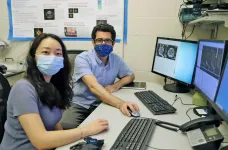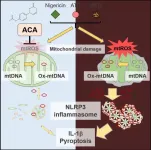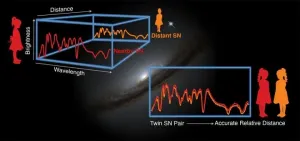(Press-News.org) RNA-based drugs have the potential to change the standard of care for many diseases, making personalized medicine a reality. This rapidly expanding class of therapeutics are cost-effective, fairly easy to manufacture, and able to go where no drug has gone before, reaching previously undruggable pathways.
Mostly.
So far, these promising drugs haven't been very useful in getting through to the well-protected brain to treat tumors or other maladies.
Now a multi-institutional team of researchers, led by Costas Arvanitis at the Georgia Institute of Technology and Emory University, has figured out a way: using ultrasound and RNA-loaded nanoparticles to get through the protective blood-brain barrier and deliver potent medicine to brain tumors.
"We're able to make this drug more available to the brain and we're seeing a substantial increase in tumor cell death, which is huge," said Arvanitis, assistant professor in the Wallace H, Coulter Department of Biomedical Engineering (BME) and Georgia Tech's George W. Woodruff School of Mechanical Engineering (ME).
Arvanitis, whose collaborators include researchers and clinicians from Emory's School of Medicine and the University of Cincinnati College of Medicine, is the corresponding author of a new paper published in the journal Science Advances that describes the team's development of a next-generation, tunable delivery system for RNA-based therapy in brain tumors.
"Our results were very positive, but if you think I'm excited, you haven't talked to oncologists - they're 10 times as excited," Arvanitis said.
The roots of this project go back to when he and the paper's lead author, ME grad student Yutong Guo, arrived at Georgia Tech in August 2016.
"From the start, I was very interested in the application of ultrasonics in treating brain disease," said Arvanitis, who linked up with Emory physician Tobey MacDonald, director of the Pediatric Neuro-Oncology Program at the Aflac Cancer and Blood Disorders Center, and one of the paper's co-authors. "Our main question was, can we use ultrasound to deliver drugs to tumors? Because that is a major challenge."
RNA drugs have two major weaknesses: limited circulation time and limited uptake by cells. To overcome these challenges, the drugs are packaged in robust nanocarriers, typically 100 nm in size, to improve their bioavailability. Still, these nanocarriers have typically been too large to penetrate the blood-brain barrier, the tightly-connected and selective endothelial cells surrounding blood vessels in the brain, until now a locked door to RNA drugs.
But now, Arvanitis and his colleagues have discovered a safe way to get the drug safely across.
Using mouse models, the team deployed a modified version of ultrasound, the diagnostic imaging technique that uses sound waves to create images of internal body structures, such as tendons, blood vessels, organs and, in the case of pregnant women, babies in utero. The researchers combined this technology with microbubbles -- tiny gas pockets in the bloodstream, designed as vascular contrast agents for imaging -- which vibrate in response to ultrasound waves, changing the permeability of blood vessels.
"Focusing multiple beams of ultrasound energy onto a cancerous spot caused the microbubbles' vibrations to actually stretch, pull, or shear the tight junctions of endothelial tissue that make up the blood-brain barrier, creating an opening for drugs to get through," Guo said.
It's a technique that biomedical ultrasound researchers have been refining for more than a decade, and recent clinical trials have demonstrated its safety. But there hasn't been much evidence for selective and effective delivery of nanoparticles and their payloads directly into brain tumor cells. But even when blood borne drugs succeed in penetrating the blood-brain barrier, if they are not taken up by the cancer cell, the job isn't complete.
Arvanitis and his team packaged siRNA, a drug that can block the expression of genes that drive tumor growth, in lipid-polymer hybrid nanoparticles, and combined that with the focused ultrasound technique in pediatric and adult preclinical brain cancer models. Using single-cell image analysis, they demonstrated a more than 10-fold improvement in delivery of the drug, reducing harmful protein production and increasing tumor cell death in preclinical models of medulloblastoma, the most common malignant brain tumor in children.
"This is completely tunable," Arvanitis said. "We can fine tune the ultrasound pressure to attain a desired level of vibration and by extension drug delivery. It's non-invasive, because we are applying sound from outside the brain, and it's very localized, because we can focus the ultrasound to a very small region of the brain."
Current standard treatments for brain tumors come with potentially awful side effects, Arvanitis said, "however, this technology can provide treatment with minimal side effects, which is very exciting. Now we are moving forward to try and identify what components are missing to translate this technology to the clinic."
INFORMATION:
Citation: Y. Guo, H. Lee, Z. Fang, A. Velalopoulou, J. Kim, B. Thomas, T. Kim, A. F. Coskun, D. P. Krummel, S. Sengupta, T. McDannold, and C. D. Arvanitis. "Single-cell analysis reveals effective siRNA delivery in brain tumors with microbubble-enhanced ultrasound and cationic nanoparticles" Science Advances, April 2021.
This work was supported by the National Institutes of Health (NIH) and the CURE Foundation.
The Georgia Institute of Technology, or Georgia Tech, is a top 10 public research university developing leaders who advance technology and improve the human condition. The Institute offers business, computing, design, engineering, liberal arts, and sciences degrees. Its nearly 40,000 students representing 50 states and 149 countries, study at the main campus in Atlanta, at campuses in France and China, and through distance and online learning. As a leading technological university, Georgia Tech is an engine of economic development for Georgia, the Southeast, and the nation, conducting more than $1 billion in research annually for government, industry, and society.
Some meat eaters feel disgusted by meat, according to a new study.
University of Exeter scientists showed food pictures to more than 700 people, including omnivores (who eat meat and other foods), flexitarians (who try to eat less meat) and vegetarians.
About 7% of meat eaters (15% of flexitarians and 3% of omnivores) had a "fairly strong disgust response" to images of meat dishes commonly eaten in the UK, like roast chicken or bacon.
As a group, omnivores rated meat images about twice as disgusting on average as pictures of carbohydrate-rich foods like bread, chips and rice.
Based on the findings, the researchers say harnessing the "yuk factor" may ...
Ikoma, Japan - Many natural compounds have various anti-inflammatory and other beneficial properties that humans have been utilizing for medicinal purposes for hundreds of years. However, the specific molecular mechanisms behind these health-promoting effects are not always clear. One such compound is 1'-acetoxychavicol acetate, or ACA, which comes from the tropical ginger Alpinia plant. Now, researchers from Nara Institute of Science and Technology (NAIST) have identified how ACA can help in the treatment of inflammatory diseases.
In a report published in International Immunology, they found that ACA attenuates mitochondrial damage through decreasing mitochondrial reactive oxygen species (ROS), blocking ...
Scientists from Nanjing University and University of Macau have discovered nano-scaled apoptotic bodies (ABs) as a new brain-targeting drug carrier, bringing new promise for the Parkinson's Disease as well as other brain diseases.
The blood-brain barrier (BBB) is the most restrictive barrier that keeps most biomolecules and drugs from the brain, setting "barriers" for the treatment of cerebrovascular diseases. With the increasingly serious ageing problem, the treatment of brain diseases now faces tough challenges, and therefore efficient brain drug delivery ...
Cosmologists have found a way to double the accuracy of measuring distances to supernova explosions - one of their tried-and-true tools for studying the mysterious dark energy that is making the universe expand faster and faster. The results from the Nearby Supernova Factory (SNfactory) collaboration, led by Greg Aldering of the Department of Energy's Lawrence Berkeley National Laboratory (Berkeley Lab), will enable scientists to study dark energy with greatly improved precision and accuracy, and provide a powerful crosscheck of the technique across vast distances ...
Computer science researchers at the University of Central Florida have developed a sarcasm detector.
Social media has become a dominant form of communication for individuals, and for companies looking to market and sell their products and services. Properly understanding and responding to customer feedback on Twitter, Facebook and other social media platforms is critical for success, but it is incredibly labor intensive.
That's where sentiment analysis comes in. The term refers to the automated process of identifying the emotion -- either positive, negative or neutral -- associated with text. While ...
Tsukuba, Japan - Scientists from the Faculty of Health and Sports Sciences at the University of Tsukuba used aerodynamics experiments to empirically test the flight properties of a new four-panel soccer ball adopted by the English Premier League this year. Based on projectile and wind-tunnel data, they computed the drag and side forces and found that the new ball was marginally more stable than previous versions but may not fly as far. This work may help improve the design of future sports equipment.
Sports players know that millions of dollars in salary and potential endorsement deals can be at stake during each match. Soccer players often complain about the aerodynamic ...
Researchers have traced the remaining last steps of the biological pathway that gives oats resistance to the deadly crop disease take-all.
The discovery creates opportunities for new ways of defending wheat and other cereals against the soil-borne root disease.
The research team have already taken the first step in this aim by successfully reconstituting the self-defence system in the model plant Nicotiana benthamiana.
Further experiments to establish the avenacin biosynthetic pathway in wheat's more complex genome, to test if it will provide the same resistance ...
They may be tiny weapons, but Brigham Young University's holography research group has figured out how to create lightsabers -- green for Yoda and red for Darth Vader, naturally -- with actual luminous beams rising from them.
Inspired by the displays of science fiction, the researchers have also engineered battles between equally small versions of the Starship Enterprise and a Klingon Battle Cruiser that incorporate photon torpedoes launching and striking the enemy vessel that you can see with the naked eye.
"What you're seeing in the scenes we create is real; there is nothing computer generated about them," said lead researcher Dan Smalley, a professor of electrical engineering at BYU. "This is not like the movies, where the lightsabers ...
May 7, 2021 - Early in the COVID-19 pandemic, healthcare systems scrambled to modify patient care processes - particularly when it came to strategies aimed at reducing the risk of hospital-related complications. A look at how one hospital applied its learning health system (LHS) framework to respond to a COVID-19-related increase in hospital-acquired pressure injuries (HAPIs) is presented in the May/June Journal for Healthcare Quality (JHQ), the peer-reviewed journal of the National Association for Healthcare Quality (NAHQ). The journal is published in the Lippincott portfolio by Wolters Kluwer.
"Given the significant challenges ...
Today, deliveries via cesarean sections, or c-sections, have become quite common globally. Sometimes, c-sections are a medical necessity when normal deliveries become risky either for the mother or the baby. At other times, it can be a choice. C-sections today have become a considerably safer procedure than it was a few decades ago, but there is need to refine it further.
In a END ...







